艺术冲突成为当前游戏音频制作新挑战
作者:Rob Bridgett
新的限制因素
今天的音频设计师用的是精致的工具,他们已经大部分摆脱了之前主机或开发环境所面临的技术限制,有着更多的选择且存在更多可能性。有些工具可以自由使用,还有高质量的音效库和合成工具,以及令人信服的管弦乐和器乐范例。我们还可以将音效放置在3D空间的任何位置,而且其采样率堪比电影音效。所有的这些先进方法为今日的音效设计师或作曲者提供了大量艺术选择。
如此广泛的艺术自由度使得艺术师不得不对其加以限制,这是前所未见的。视频游戏音频的协作性和创意性对主机的性能发起了挑战,有些团队甚至开始讨论他们作品所受到的艺术限制。
之前限制艺术表达的是技术,但现在已经转变成经济、艺术和以产品为基础的限制。
削减音频方向或美学是项艰巨的任务,而设定限制正是关键所在。
视频游戏的音效范围都各种不同的方式,其最终目标都是创造支持艺术及技术方向和更广阔的产品支柱及游戏设计架构的音效方向。
在开发过程中,产品受到许多不同方向的力量作用,或者修正问题,或者将想法进一步神话,或者将玩家注意力带离某些游戏中不甚精致的元素。
题材愿景
重要的是应该意识到,在今日成熟的主机循环中,限制不是来源于技术,而是来源于游戏类型以及游戏本身需要(游戏邦注:或期望能够实现的)音乐和音效。那些成功的游戏类型的美学设计有一定的范围,尤其是对那些所谓的AAA级系列游戏。
现在许多游戏根据题材来划分,因而人们会根据题材期望游戏能有何种音效。游戏与其题材间的关系至关重要,开发商可以选择采用保守的安全做法,也可以选择在艺术方向上进行创新。
一般音效无非就是一般游戏和一般游戏开发过程的副产品,其原创性已经消失殆尽,采用的只是该题材预期的音效范例。毕竟,音效设计的首要功能是要为游戏提供支持。因而在诸多情形中,创新的欲望可能会使得音效设计与产品目标间存在冲突。
在这种背景下,器乐、好莱坞电影管弦乐以及现实主义(游戏邦注:在游戏中进行夸张化处理)武器音效设计风格在过去十年间成为许多AAA级游戏的宠儿。尽管创造这些音效使得产品质量、艺术性质和行业受到众人的大加赞赏,尽管几乎不可能有人萌生出另辟蹊径的优秀想法,但原创性的丧失还是令人扼腕叹息。
艺术方向
有个领域时常让我萌生兴趣,那就是音效、音乐及声音与画面配合创造出的含义。当音乐和音效与画面同步时会产生某种特殊的魅力,一旦经历过,人们就无法在脑海中将它们分开。
或许与音频协调最丰富的领域是艺术方向。有人可能会开始辩解称,游戏音效越独特或有趣,艺术上受到的限制就越大。反之亦然,精致和独特的视觉效果也会限制到音效。以下想法或许挺符合逻辑:因为视觉效果受到带宽的限制,音效设计和音乐选择为与其保持一致也会受到限制。
这并不是说音轨不会在游戏开发时影响其视觉风格,但在游戏世界中,通常会首先注意到视觉效果。
也就是说,玩家首先接受的是游戏的视觉效果而不是音效,虽然音频质量应该在此过程中扮演主导角色。
似乎游戏设计师或作曲者必须遵从游戏的方向和基调来进行设计,至少在艺术总监和游戏总监间的谈话中是这样表现的。
在游戏早期概念阶段,音效也活跃参与其中,在制作过程中它充当合作者的角色,随后艺术方向和音效方向会迅速根据两个方向中的想法和灵感开展创意性配合。
交替美学的成功
正如我之前说过的那样,近期出现了大量一般音效游戏,其中绝大多数是射击类游戏。然而,有着特殊音轨的游戏也已经浮现出来。
我想说的是,过去数年来出现了三种音频方向,与独特的艺术方向配合。
所有这些游戏的视觉交过和音频都清晰易辨。有趣的是,这些游戏都是那些已经在游戏行业中确立自己地位的题材,但每款游戏都采用了特别的艺术方向。
第一人称射击。《生化奇兵》利用20世纪40年代的音乐资源营造出真实的感觉,而且有秩序地整合到整个游戏世界中。音乐将各个艺术方向融合起来,让玩家沉浸在独特的虚拟故事中。
除此之外,游戏在许多话语中使用了大西洋中部口音,这种强烈且清晰的声音方向极其准确地体现出时间和位置。这款游戏的整体效果非常依赖音轨,很难想象如果没有如此强大清晰的音频方向游戏会变成什么样子。
平台游戏。《LittleBigPlanet》给人带来的音频美学感是细致活泼,然而却好似都是随意构建支持的音效和音乐模块,支持和强调了游戏独特艺术方向、角色设计和游戏设计架构中内在的活泼性。
音乐似乎并非紧紧联系在一起,而是根据游戏视觉场景来展现各个片段。这也是款脱离音频方向便难有成就的独特游戏。
《Limbo》唯美精致的洛可可式音效设计、音乐和功能与其温和的黑白艺术方向相辅相成。
玩游戏的首个小时就可以发现,游戏格外关注设计和玩法结构中音效的重点和细节。这款游戏与其他有着粗糙色彩和音效的其他平台游戏完全不同。
通过以上这些游戏可以发现,在研发后期可以相对容易地抛弃那些与艺术方向或在音效本身规划中不相符和音效。艺术方向或产品方向清晰地界定了音频方向,音轨自然而然就受到了限制。
选择X重复=方向
在电影音效中,就在某一时间可以播放的音效数量(游戏邦注:此音效数量比游戏中要多)以及某个音效能够承载的效果,音效设计师所受到的技术限制相对较小。
电影音效所受到的限制完全就是美学,而寻找破除这些限制的过程就是一段实验性的过程,即通过整体考虑画面来探寻从某个时间点到另一个时间点中的音轨是否能够产生作用。
作为游戏音频总监、音效设计师和作曲者,我们的工作当然也需要发现和设置同样的美学限制和界限。其中大部分过程与电影制作类似,即尝试不同的音效并反复播放内容,找到能够产生作用并让人感觉良好的音效。
在音效方面,我们需要的不只是单纯依靠直觉来判断是否有效,而应该倾听并尝试不同的想法。这也是为何很容易在此过程中融入他人想法和建议的原因。
这个过程起始时需要有着大量的选择,然后逐一尝试找出那些有效且支持艺术方向的音效,这对创意性方向的产生至关重要。当游戏中现有想法无法发挥作用时,就需要不断进行尝试探索,而且需要持续相当长一段时间直到找到合适的做法。在此过程中,团队协作也是很重要的。
对某些人来说,或许他们主要是从电影音效层面来考虑,视频游戏音效由技术执行来决定依然会限制其创意性。对其他人来说,限制的存在创造了很有价值的创意性挑战、机会和独特的解决方案。对于我们这些看着行业数十年来变迁长大的人来说,这种挑战逐渐从技术层面转变至艺术层面。
最后,只有合作和重复性工作才会使得作品充满创意性。也就是说,产品艺术限制的定义需要团队通力合作。(本文为游戏邦/gamerboom.com编译,如需转载请联系:游戏邦)
Sound Friction: Collaborative Challenges In Games
Rob Bridgett
New Limits
Today’s audio designer, working with refined tools, is largely freed from the technical constraints imposed by prior console or development environments, and has entered a comparatively luxurious age of choice and possibility. There are freely available, high quality sound libraries and synthesis tools, as well as convincing orchestral and instrumental samples. We also have the ability to place sounds anywhere in 3D space at sample rates comparable to film sound. All these advancements give today’s sound designer or composer a bewildering array of artistic choices.
It is precisely these wider artistic freedoms that are now more than ever desperately in need of having limits ascribed onto them. This feature will start to tease out some of the collaborative and creative challenges and expectations within console based video game audio, as well as starting to talk about some of the ways in which teams work together to establish direction or artistic limitations on their work.
While technical limitations have until recently provided convenient aesthetic constraints for the industry, the limitations are now being provided and even deliberately sought elsewhere: artistic, economic, artistic, and production-based limitations.
Narrowing down an audio direction, or aesthetic, can be a difficult task, and establishing limitations are absolutely key to this.
The soundscape for a video game can be imagined or interpreted in a million different ways, with the end goal of creating a sound direction which supports the artistic and technical direction and the wider product pillars and game design architecture.
During the course of a production it is also pulled in many different directions, to either fix problems, push ideas further or even as a distraction to draw attention away from certain less polished elements of the game.
Expectations of the Genre
It is important to realize that, the limits today, in the middle of a mature console cycle, rather than from the technology, are coming from the kinds of games and the kinds of music and sounds being requested (and expected) by the games themselves. The kinds of games that are going into production, and are deemed to be successful are, on the whole, becoming more narrow in their aesthetic, particularly within the so called “triple A” space of franchises.
Many games are defined now by their genre, and indeed the expected sound of these games is also driven by the expectations within those genres from the top down. The relationship a game has to its genre is a critical one; it seems that there is a choice to either play it safe, or to innovate with art direction.
Generic sounding games are nothing more than a by-product of generic games and a generic game development process in which originality is flattened into the expected sound paradigm of a given genre (call it a Hollywood focus group mentality if you will). It is, after all, the primary function of the sound design to support the game, so in many cases the desire to innovate may put the sound designer in direct conflict of interest with the product goals.
In this context, an instrumental, orchestral Hollywood film score paradigm, as well as a realistic (yet exaggerated) weapon-based sound design style, has been ascendant for at least the last ten years within many triple A titles, and while the production quality, artistry and craft involved in creating these scores and sound mixes is to be admired and applauded, and while it is not always possible, and not always a good idea to do something different, one can’t help but lament the lost opportunities to have done something unique.
Artistic Direction
An area that has always fascinated me is the way that sound, music and voice work with, or against an image to create meaning. There is a magnetism that occurs when music and sounds are synced to the image, which once experienced, one cannot imagine them ever having been apart.
Perhaps the richest area for collaboration with audio is with the art direction. One could perhaps begin to argue that the more unique or interesting sounding games are often the more aesthetically “limited”, or those that work within a very clearly defined and unique visual vernacular. A good rationale to begin thinking about this is that because the visuals are focused into such a narrow bandwidth, the sound design and musical choices can be relied upon more than usual in order to fill in what the other senses are lacking.
This is not to say that the soundtrack cannot influence the visual style of a game as it develops, but that more often the first steps in defining a unique game world are made within the visual realm.
“Buy-in” is more often visual than it is audible at the product greenlight process (although quality audio can often and should play a leading role in this process).
Concept art and look and feel videos are often the first exposure the sound designer or composer will have to the game’s direction and tone, at least beyond conversations with the art director and game director.
Provided sound is an active participant in the early concept stages, and is a collaborator throughout production, then a creative synergy can quickly develop between the art direction and the sound direction with ideas and inspiration flowing in both directions.
The Success of the Alternate Aesthetic
As I have already said, there have been recently a large amount of generic sounding games, mostly shooters, yet almost in rejection of this aesthetic, exceptions and examples of games with very different soundtracks have emerged.
I’d like to call out three examples of audio direction within the last few years that have been striking in their partnership with unique art direction.
All these examples have a focused and immediately clear vision; both sonic and visual that can be instantly recognized. It is interesting to note that these examples are all in firmly established and hugely popular genres, yet in each example have adopted a radical art direction.
First Person Shooter. BioShock’s use of source music from the 1940s gave the game a sense of distorted realism, but this was very much a part of the vision for the entire game universe itself. This music formed a cohesive skin over the art direction which served to immerse the player in a unique historical fiction.
In addition to this, the strong use of the mid-Atlantic accent in many of the voice performances solidified a strong and clear voice direction which was extremely evocative of time and place. This title relied so heavily on the soundtrack for its effect, that it is impossible to imagine this game functioning without such a strong clear and narrow audio direction.
Platformers. LittleBigPlanet’s audio aesthetic: minimal, playful yet endlessly customizable building blocks of sound and music that support, underpin and emphasize the playfulness inherent in the game’s unique art direction, character design and game design structure.
Rather than seamlessly flowing together, the varied pieces of music work together much like the patchwork evident in the game’s visual assets, nowhere is this aesthetic more evident than in the many user created online levels. Again, a difficult game to imagine working without the many unique aspects to its audio direction.
Limbo’s beautiful, subtle, soft and detailed rococo sound design, and under-reliance on music, functions hand in hand with the muted, de-focused monochrome art direction.
While putting the Foley center stage for the first hour or so of the game focuses the importance and detail of movement within the game’s design and game play structure. An ambient title that is in total contrast to much of the platforming genre’s raucous color and sound.
With each of these titles, during the tail end of production, it would be relatively easy to discard sounds that did not belong fit their aesthetic or belong in their worlds. When an art direction, or product direction, is so clearly defined like this, and interwoven into the fabric of the audio direction, the creative opportunities for the soundtrack are satisfactorily narrowed.
Choice x Iteration = Direction
In the world of film sound, the sound designer can be said to be comparatively free of technical restraints in terms of how many sounds can be played back at any one time (certainly even more so than in games), the amount of effects that a sound can be processed with, as well as rendering sounds at the highest accepted notions of full-bandwidth surround sound.
The constraints in film sound are, or at least should be now, exclusively aesthetic (similar technological and aesthetic growth rings and codependencies can be found in the history of sync film sound, from optical, to mag, to digital) and seeking out these constraints boils down to a process of experimentation, finding out what does and does not work for the soundtrack from moment to moment and throughout the many narrative arcs of the picture as a whole.
As game audio directors, sound designers and composers, our jobs absolutely require similar aesthetic limits and boundaries to be discovered and set. Much of this is achieved in a similar process to that of film, a process of trying out different sounds, iterating on content and honing into something that “works” or “feels right”.
With sound, it is more a process of actually listening and trying ideas out rather than of solely relying on instinct for what might or might not work. This is also why it is easy and important to incorporate other people’s ideas and suggestions into this process.
This process of starting with wide choices, trying them out in order to narrow them down to sounds that both work and support the artistic vision, is critical to the creative process of establishing a direction. This exploratory technique is often required on games where the immediate vision isn’t apparent from the outset, but which needs to be worked on constantly for a long period of time before the clarity of vision emerges. It is also important that this is a collaborative effort, in whatever way works within the given team structure.
The degree to which video game sound is still determined by and reliant upon technical implementation, to some, perhaps mainly from a film sound perspective, is seen as a limitation on creativity. To others the existence of limits presents valuable creative challenges, opportunities and unique solutions. For those of us who have grown with the changes over the last ten or so years in the industry, the challenges have certainly shifted emphasis from the technical to the artistic.
In the end, it is a collaborative and iterative process that enables the work to be creative and fulfilling during production for the creators and compelling for the player, as a team works together in order to define the artistic limits of the product they are creating. (Source: Gamasutra)
下一篇:探讨游戏设计中用户界面的各种形式









































 闽公网安备35020302001549号
闽公网安备35020302001549号